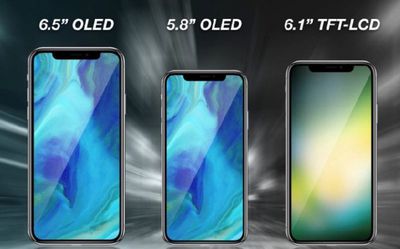LG Display has signed a deal with Apple to supply both LCD and OLED panels for the company's 2018 range of iPhones, according to a new report by Korea-based Newspin (via DigiTimes).
The contract will see LG Display ship around 20 million LCD smartphone panels to Apple in 2018, according to the report, which also puts the number of OLED panels to be supplied by LG in the 3 to 4 million ballpark range, as per previous rumors.

In addition, the report claims LG is "likely" to secure the majority of 6.5-inch panel orders from Apple in 2019, which will see the firm ramp up its OLED shipments to 10 million units in the year. LG will reportedly produce the OLED panels for iPhone at its E6 6G plant in Paju, Korea.
Apple is expected to launch two OLED iPhones (5.8 and 6.5 inches) and one 6.1-inch LCD iPhone later this year, with the LCD device to be positioned as a low-cost option alongside the two more expensive OLED devices.
It's unclear at present what the reported LG-Apple deal means for LCD suppliers Sharp and Japan Display, the latter of which is trying to raise millions through third-party share allocations and asset sales in order to have the necessary funds to supply LCD screens for Apple's new iPhones.
Last year, Japan Display lost business because of Apple's shift to OLED, and with the firm again planning to invest in LCDs, it could be in trouble in the future, should Apple increasingly turn to Samsung and LG for both panel types.
DigiTimes has previously claimed Apple will seek 60 to 70 million LCD panels for its iPhones this year, but whether that number is destined solely for the new 6.1-inch model is unknown. Apple has already earmarked $2.67 billion to invest in LG's OLED panel production, with the Korean firm said to be building a production line dedicated to iPhone orders only, as part of its agreement with Apple.
Apple's desire for both LCD and OLED supplies also comes at a crucial time for LG. The company posted a net loss of 98.3 billion Korean won ($87 million) in the first quarter of 2018, with the prospect of almost doubling that figure in losses for the second quarter.
LG's financial constraints also underline the importance of avoiding a repeat of the firm's past OLED mistakes, such as befell its Flex and G Flex 2 phones, released in 2013 and 2015, respectively. Both smartphone displays were widely criticized at the time for exhibiting graininess and variations in brightness, issues which returned in LG's own V30 and the Google Pixel 2 XL in models launched last year.
























Top Rated Comments